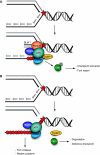FANCM: fork pause, rewind and play
- PMID: 20160754
- PMCID: PMC2829172
- DOI: 10.1038/emboj.2009.415
FANCM: fork pause, rewind and play
Abstract
DNA lesions or genomic regions that are difficult to traverse frequently hinder or block DNA replication. In response to replication fork stalling, the cell activates the replication stress response pathway, which acts to protect the fork from collapse, promotes the repair or bypass of the blockage and facilitates the resumption of DNA synthesis. In this issue of the EMBO Journal, two studies conducted by the Constantinou and Niedzwiedz laboratories shed light on how the DNA translocase FANCM acts to regulate the replication stress response (Luke-Glaser et al, 2009; Schwab et al, 2009). These studies help to explain how FANCM (mutated in the human cancer predisposition syndrome, Fanconi's anaemia (FA)) co-ordinately regulates checkpoint signalling and replication fork progression.
Conflict of interest statement
The authors declare that they have no conflict of interest.
Figures

Comment on
-
FANCM regulates DNA chain elongation and is stabilized by S-phase checkpoint signalling.EMBO J. 2010 Feb 17;29(4):795-805. doi: 10.1038/emboj.2009.371. Epub 2009 Dec 10. EMBO J. 2010. PMID: 20010692 Free PMC article.
-
ATR activation and replication fork restart are defective in FANCM-deficient cells.EMBO J. 2010 Feb 17;29(4):806-18. doi: 10.1038/emboj.2009.385. Epub 2010 Jan 7. EMBO J. 2010. PMID: 20057355 Free PMC article.
References
-
- Collis SJ, Ciccia A, Deans AJ, Horejsi Z, Martin JS, Maslen SL, Skehel JM, Elledge SJ, West SC, Boulton SJ (2008) FANCM and FAAP24 function in ATR-mediated checkpoint signaling independently of the Fanconi anemia core complex. Mol Cell 32: 313–324 - PubMed
-
- Deans AJ, West SC (2009) FANCM connects the genome instability disorders Bloom's syndrome and Fanconi anemia. Mol Cell 36: 1–11 - PubMed
-
- Kumagai A, Lee J, Yoo HY, Dunphy WG (2006) TopBP1 activates the ATR-ATRIP complex. Cell 124: 943–955 - PubMed
Publication types
MeSH terms
Substances
LinkOut - more resources
Full Text Sources
Miscellaneous

